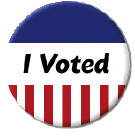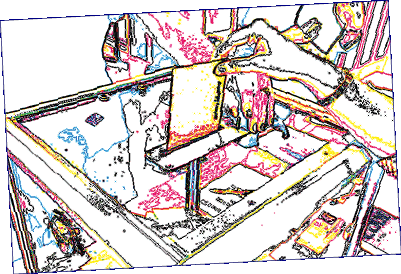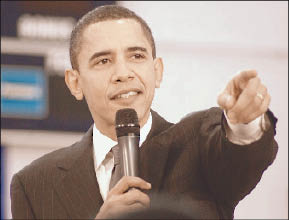 |
| Photo: Marc Nozell |
Here’s something you don’t often hear before an election: The youth vote is expected to be big.
It’s been rising for several years. Voter turnout among 18- to 29-year-olds rose by 9 percent in 2004, the largest increase since 18-year-olds earned the right to vote in 1971. This year, record numbers of young voters turned out for the presidential primaries. The candidacy of Democrat Barack Obama, and his close race with Republican John McCain, is expected to spur a huge turnout of young voters in November.
That, however, raises an important question: Can efforts to increase the youth vote succeed independently of the buzz around one candidate? Already, the Obama Factor has caused a drop in funding for and interest in youth vote efforts by nonpartisan groups, says Alex Arnson, youth vote director for The Bus Project, in Oregon. “There’s a perception the Barack Obama campaign will fund the youth vote,” he says. “But that’s not good. We have to look at the long term.”
Here is what looking at the long term means.
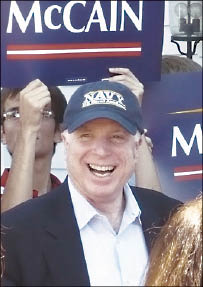 |
| Photo: Vorlagen/Bildizenz |
First, it isn’t cheap. In 2004, partisan and nonpartisan groups spent more than $40 million on youth voter registration efforts, according to the Center for Information and Research on Civic Learning and Engagement (CIRCLE), based at Tufts University in Medford, Mass. A record 20 million under-30s voted that fall, almost half of all 18- to 29-year-olds, according to the U.S. Census Bureau. Voting in the last presidential election increased among 18- to 24-year-olds by 11 percentage points.
Second, it works best when it’s personal. Youth voting and civic engagement activists say a one-on-one approach is most successful. Research from CIRCLE’s Young Voter Mobilization Tactics shows that door-to-door contact, whether partisan or nonpartisan, generally costs from $10 to $14 per additional vote. That strategy is most cost-effective in dense neighborhoods, apartment buildings and places where young people congregate.
CIRCLE research shows that the medium used to recruit young voters has a bigger impact than the message. “What works is the interactivity,” says Peter Levine, director of CIRCLE. “The more the message is just an opening for discussion, the better the result.”
Young people respond to personal discussion, even on the phone, especially if the script is longer and conversational. Interactive phone calls cost about $10 a vote, according to CIRCLE. Levine says robo-calls definitely don’t work, costing as much as $275 per additional vote. CIRCLE research shows that direct mail is also ineffective, costing from $40 to $200 per vote.
Civic organizations shouldn’t overlook the power of technology either. According to figures from The Pew Research Center, 70 percent of 18- to 29-year-olds use the Internet daily. That’s one reason why online voter registration has gained momentum in recent years through popular sites like http://RocktheVote.com and http://DeclareYourself.org. Reaching out to young voters through the Internet is cheap, too. According to online registration test results from Washington-based Rock the Vote, it costs $2 to $10 to register a young voter online.
Online social networks are another great outreach tool. Rock the Vote research shows it’s worthwhile for candidates to to set up a profile on popular sites like MySpace and Facebook.
Another factor is that a nonpartisan approach isn’t always the most effective. CIRCLE’s research shows that door-to-door canvassing has been more effective when it involved contact on behalf of a particular candidate, as opposed to a general call to go to the polls.
“It can be more difficult to mobilize people for a nonpartisan approach,” says Matthew Segal, executive director of Student Association for Vote Empowerment (SAVE), “but at the same time, a partisan registration drive is going to turn some people off.”
Hard to Reach
Even with the right approaches, most youth voter registration efforts face similar challenges in reaching certain populations.
Many efforts focus on college students, who make up less than 45 percent of eligible American voters under 25, according to U.S. Bureau of Labor Statistics for 2005.
Levine at CIRCLE points out that turnout for the Super Tuesday primaries this year among college-age young people who were actually in college was one in four; turnout among non-collegians in the same age group was one in 14. “It’s really important to reach kids not heading to college,” he says. “They have dramatically lower voting rates, and they’re harder to reach and much less confident.”
“The majority of young people are not in college and can’t take the time off to go vote,” says David Burstein, founder of 18 in ’08, a voter registration and participation effort, based in New York. That’s one reason his project tries to create partnerships with organizations working on youth civic engagement in their own communities, like Generation Engage.
Burstein says youth voting organizations also need to target high schools better, reaching youths before they hit voting age. “It’s hard to ask people at 18 to suddenly get involved in politics.”
That’s why Kids Voting USA sponsors mock elections for youths, in which they go to polling places with their parents and vote (at special kids’ booths) on the same issues. “We’ve found that kids who participate in Kids Voting register to vote [years later] at a higher rate than their non-participating counterparts,” says Jack Barse, president and CEO of Kids Voting USA.
Levine at CIRCLE believes the more exposure young people receive to civic education before 18, the more likely they are to become actively engaged adults. He says youth are open to discussing public issues and news events in school. “The chance for dialogue is key to them.”
Another issue, according to SAVE, is that young people who attend out-of-state colleges can’t register in some states, don’t know they can in others, or don’t have easy access to registration. “We could have incredible turnout this fall,” says SAVE’s Segal. “But we don’t know if those young people will actually be able to vote.”
SAVE strives to institutionalize voter registration on college campuses.
Student Association for Voter Empowerment (SAVE)
Washington, D.C.
847-502-5012
http://www.savevoting.org
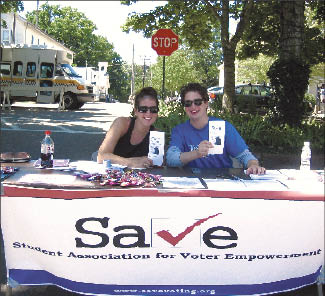 |
|
Old reliable: Registration tables at campus still do the job.
Photo: Student Association for Voter Empowerment |
The Strategy: Enlist college leaders in backing efforts to institutionalize voter registration on college campuses.
This student-founded group launched the nonpartisan SAVE’s College President Commitment program earlier this year, with the goal of getting the college administrations at SAVE chapters around the country to allow voter registration tables at freshman orientations this fall.
Getting Started: SAVE, based in Washington, was founded by Kenyon College graduate Matthew Segal a year and a half ago after he had to wait in line for more than seven hours in 2006 to vote in Gambier, Ohio (home of Kenyon).
Putting It Together: SAVE was founded in 2007. In addition to the College Presidents’ Commitment program this fall, SAVE will launch a program in partnership with http://ResidentAssistant.com. The new project’s goal is to train 25,000 RAs at campuses around the country to help educate and register college-age voters. Some of SAVE’s chapters are also working to train college students to be poll workers to give them greater exposure to the civic process.
Staff: SAVE has six staff members at its Washington headquarters. All are volunteers, although SAVE covers their expenses. In addition, the organization has 30 chapter heads who recruit volunteers on campuses around the country.
Money: Segal says SAVE’s annual budget is about $50,000, and individual college chapters work with even less funding. The annual budget for SAVE’s Colgate University chapter, for example, is about $1,000. Funds for the headquarters come primarily from private donations.
Results: To date, 13 college presidents have signed the College Presidents’ Commitment, and SAVE has established chapters on 31 college campuses. SAVE was one of the lobbying groups that helped promote a bipartisan bill introduced by Sen. Dick Durbin (D-Ill.), and representatives Jan Schakowsky (D-Ill.), and Steven LaTourette (R-Ohio) that would require colleges and universities that receive federal funding to offer voter registration services for students when they register for classes.
The Bus Project
Portland, Ore.
(503) 233-3018
http://www.busproject.org
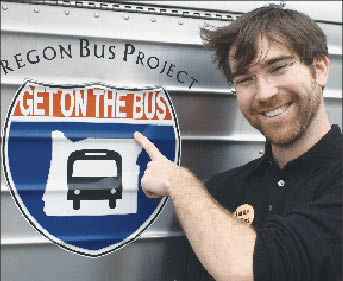 |
|
Scoot Over: Aronson, whose Bus Project has registered 20,000 voters in 2006.
Photo: The Bus Project |
The Strategy: Encourage peer-to-peer discussion and voter registration by driving a bus around the state so volunteers can knock on doors for a particular candidate. Nonpartisan efforts include training young people on how to approach strangers, serve as neighborhood captains to register voters and collect voter registration cards.
Getting Started: A group of friends in their mid- to late 20s started the project in 2002 to get young people to play a larger role in Oregon politics. “It began as a candidate support mechanism for progressive candidates in swing districts,” says Youth Vote Director Alex Aronson. The group’s first bus, which was bought used, cost $11,000.
Putting It Together: The bus portion of the project continues to support progressive candidates by making 15 bus trips a year with volunteers who go around the state knocking on doors urging people to vote progressively.
A nonpartisan arm known as Building Votes was added in 2006. It sponsors programs year round to increase voter registration among young people, through such efforts as visiting high schools, sponsoring street fairs and beer festivals, and encouraging volunteers to recruit voters in their workplaces.
PolitiCorps, another part of the Bus Project, is a 10-week summer program for college-age students that includes workshops on grass-roots organizing, state politics, policy making and volunteer recruitment. The program is free, and each PolitiCorps fellow receives a $1,000 living stipend for the summer.
Youth Served: The Bus Project and Building Votes target 18- to 29-year-olds in Oregon. The Bus Project recruited 800 volunteers during the 2004 election year.
Staff: The project has a dozen paid staffers statewide working on projects throughout the year, and 30 to 40 during local and state election years.
Money: The annual budget is nearly $1 million. Funders include the Pew Charitable Trust and The Carnegie Foundation. More than 40 percent of the budget comes from individual donors who are members of The Bus Project and donate anywhere from $10 to several hundred dollars each month. Arnson says the project has 400 of these members, and he wants to keep cultivating them so it can be self-sustaining.
Results: In 2006, Building Votes registered 20,000 voters. That year, the number of voters under 30 participating in the election in Oregon rose by 6 percent.
Tribal Elections Curriculum Kids Voting South Dakota
Rapid City, S.D.
(605) 341-4311
http://www.chiesman.org
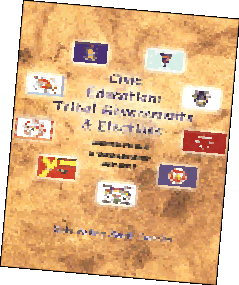 |
|
Nine tribal flags grace the cover of KVSD’s voting curriculum.
Photo: Chiesman Foundation For Democracy |
The Strategy: Build a curriculum that can be used in social studies, language arts and math classes, with specific attention to the elections and government of Native American tribes across the state of South Dakota.
Because Native Americans didn’t begin to gain enfranchisement in the United States until 1924 and didn’t have voting rights in some states until the 1960s, their voting experience has differed significantly from that of most other Americans. They also have their own governance within their reservations.
“The Tribal Elections Curriculum gives ownership to tribal schools,” says KVSD Director DeVee Dietz. “They have different issues, and their governments are run differently.” The curriculum also covers state and national election issues.
Getting Started: The project is new. Kids Voting South Dakota (KVSD) has been at work in the state since 1992 as an affiliate of the larger national organization Kids Voting USA, which was founded in 1988. Recently, teachers at reservation schools approached KVSD about a curriculum designed to meet the unique needs of their Native American students. “They wanted a curriculum relevant to tribal elections and tribal government,” says Dietz.
Putting It Together: In collaboration with representatives from South Dakota’s nine Native American tribes, reservation teachers and KVSD staff members developed a curriculum that addresses the history of Native American voting in the United States, as well as the functions of and election processes for tribal governments.
Youth Served: The Tribal Elections Curriculum pilot project plans to reach about 500 students in 25 K-12 classrooms on nine reservations across South Dakota this school year. The pilot project will focus on the Shannon County School District and the Rosebud Reservation.
Staff: The Tribal Elections Curriculum uses three half-time staffers of KVSD.
Money: Initial funding for the statewide KVSD project came from a U.S. Department of Education Development and Demonstration grant and a Legislative Education grant. Other funders include State Farm Insurance, South Dakota Rural Electric Association, East River Electric Cooperative and Touchstone Energy Cooperatives. Specific funders for the Tribal Elections Curriculum are the Chiesman Foundation and the Chiesman Center for Democracy. Tribal schools will pay KVSD $5 for each teacher’s curriculum kit and about 35 cents for each student.
18 in ’08
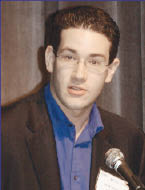 |
|
Burstein: Group goes “beyond registering.”
Photo: 18 in ’08 |
New York, N.Y.
(203) 919-1270
http://www.18in08.com
The Strategy: Tap into interest in the 2008 campaign with a 35-minute film in which well-known politicians and other celebrities discuss why each vote is important, and follow up with voter registration.
The film explores how 18-year-olds obtained the right to vote during the Vietnam War, why young people aren’t voting in greater numbers, and how young people can become more civically engaged.
Executive Director David Burstein shows the film at “town hall” functions across the country, at colleges, high schools, diners and even at Bloomingdale’s. Staffers bring voter registration forms or work with college campus organizations to set up a voter registration process after each screening.
“Our goal goes beyond registering people to vote,” Burstein says, “but registration is the biggest barrier to acquiring the youth vote.”
Getting Started: David Burstein, now a 19-year-old student at Haverford College in Pennsylvania, helped create the Westport Youth Film Festival in his hometown of Weston, Conn. He got the idea for his “18 in ’08” film after the 2004 presidential election. “We got increased turnout among youth voters that year, but not enough,” says Burstein. “I wanted to try a youth-run organization to encourage young people to vote.”
Putting It Together: Burstein began work on the film in 2004, interviewing more than 60 presidential candidates, member of Congress, activists and observers. Those appearing in the film include John Kerry, Jeb Bush, Sam Donaldson, Joe Lieberman and Richard Dreyfuss.
Youth Served: Screenings of the film began in February; as of mid-July, “18 in ’08” had been shown more than 400 times. Burstein estimates that 80,000 to 100,000 people have seen it.
Staff: The 18 in ’08 organization is almost entirely volunteer-run, with seven regular team members in addition to Burstein. The group also has 10 consultants and advisers, some of whom are paid, working on various projects from database management to website design and maintenance.
Money: The project became a nonprofit just last summer, and Burstein estimates its annual budget at $10,000 to $20,000. The funds come from private family foundations, as well as from fees charged for film screenings and speaking fees collected by Burstein; 18 in ’08 also charges licensing fees for colleges that show the film.
Results: Between February 2008 and mid-July, the project registered more than 21,000 young people to vote. Burstein says high schools in 30 states are using the film in their curricula.


